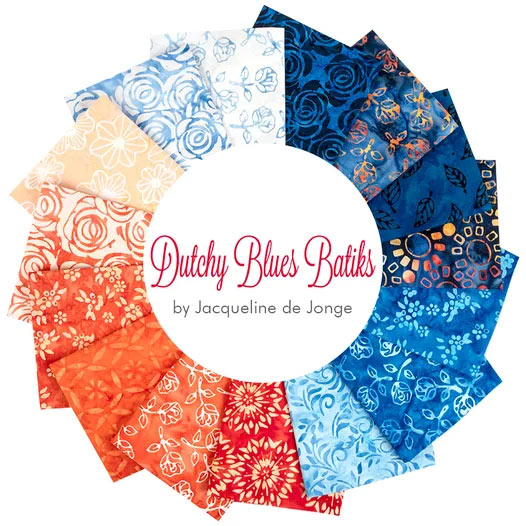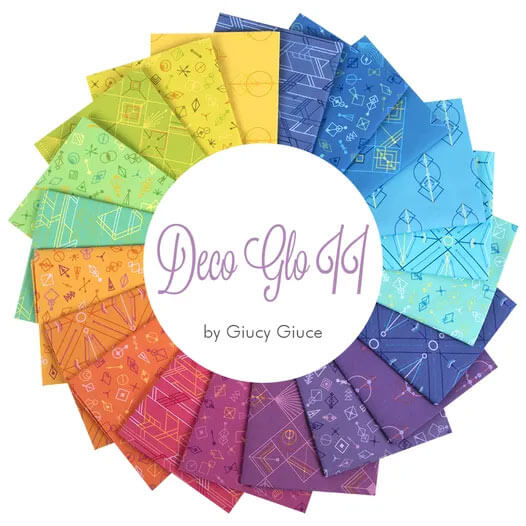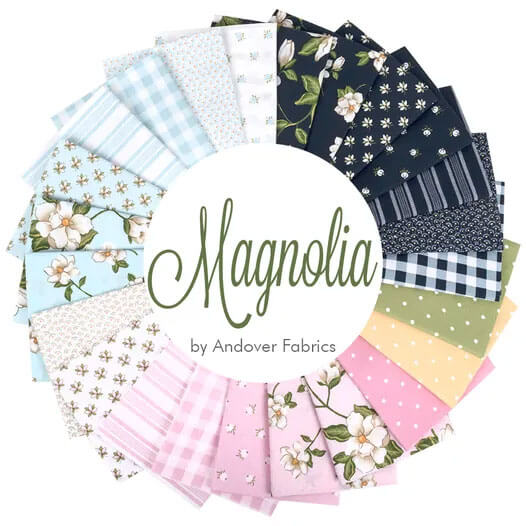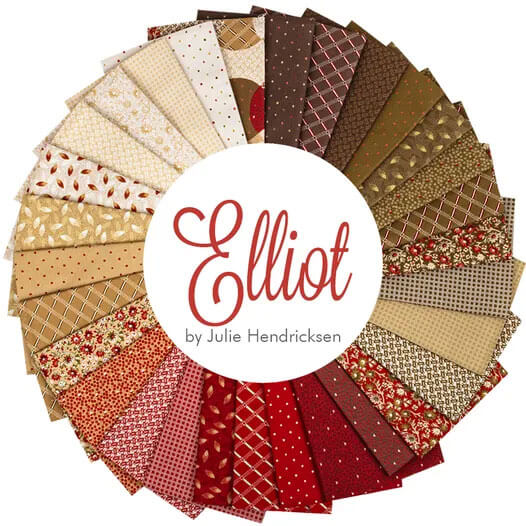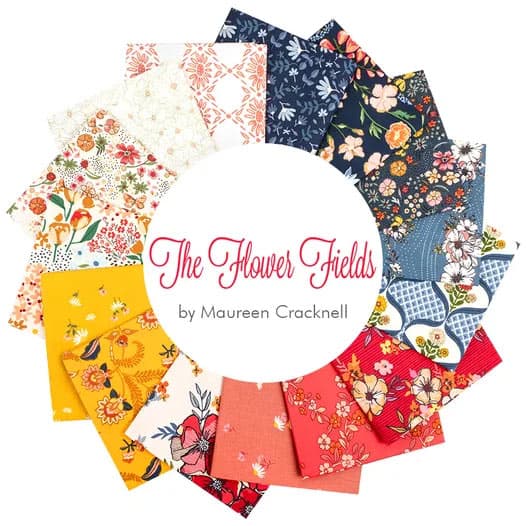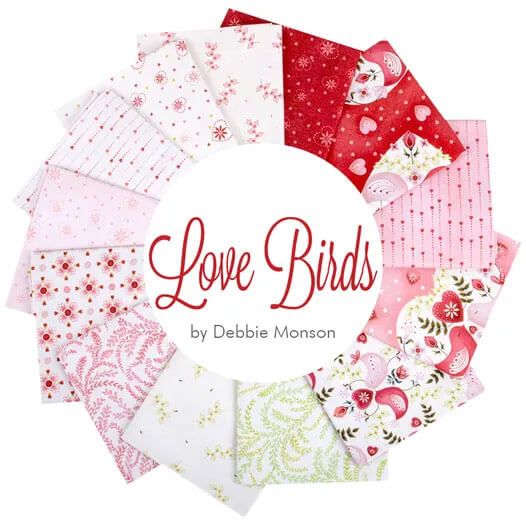- Home
- Free Quilt Block Patterns
- Buckeye Beauty Quilt Block
Buckeye Beauty Quilt Block Pattern
From our Free Quilt Block Patterns Library
This post contains affiliate links for which I receive compensation.
Skill Level: Beginner
The Buckeye Beauty quilt block is super fast and easy--just two half square triangles and two four patches and you're good to go!
Perfect for scrappy quilts because each block takes so little fabric. As always, scrap quilts are all about value. Keep your lights light and your darks dark to maintain the design.
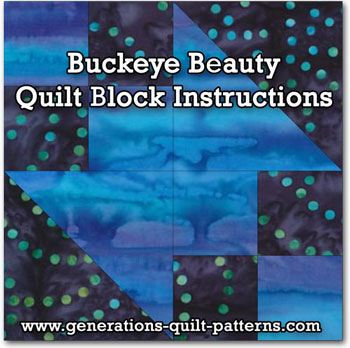
For such a small block with so few pieces, it's hard to believe there are many other names, but here they are:
Double Four Patch
Gay Scrap Quilt
Give This One a Name
Going to Chicago
Hour Glass
Jacob's Ladder
New Four Patch
Northern Lights
Railroad
Railroad Crossing
World's Fair
Railroad
World's Fair
The underlined links above lead to other quilt patterns on this website.
Quilting instructions are included on this page for blocks in 5 different sizes.
Variations on the design are included at the end of this page.
Now let's start piecing this beauty!
General Instructions
All seam allowances (SA) are 1/4".
When you are instructed to press, first press the pieced unit flat to set the seam. Then open the patches, pressing from the front.
Seam allowances are pressed to the darker fabric unless otherwise noted.
The newest quilt fabrics to tickle your fancy...
Click the images below to see the full collection. We share any commercial and/or free patterns that showcase them, too. (For inspiration, of course!)
Step 1: Cutting for a Buckeye Beauty
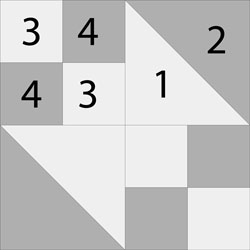 Buckeye Beauty quilt block
Buckeye Beauty quilt blockThe squares for the half square triangles (marked with **) are based on using the Quick Piecing technique.
I like to use over-sized squares, stitch the unit and then trim to an exact size.
 | Cutting Chart for a~ Traditional Piecing ~ | ||||||
|---|---|---|---|---|---|---|---|
| Patch | Fabric | Qty | Finished Block Size | ||||
| 3'' | 4'' | 5'' | 6'' | 7'' | |||
| 1** | Light | 1 | 2⅜'' x 2⅜'' | 2⅞'' x 2⅞'' | 3⅜'' x 3⅜'' | 3⅞'' x 3⅞'' | 4⅜'' x 4⅜'' |
| 2** | Dark | 1 | 2⅜'' x 2⅜'' | 2⅞'' x 2⅞'' | 3⅜'' x 3⅜'' | 3⅞'' x 3⅞'' | 4⅜'' x 4⅜'' |
| 3 | Light | 1 | 1¼'' x 6'' | 1½'' x 7'' | 1¾'' x 8'' | 2'' x 9'' | 2¼'' x 10'' |
| 4 | Dark | 1 | 1¼'' x 6'' | 1½'' x 7'' | 1¾'' x 8'' | 2'' x 9'' | 2¼'' x 10'' |
| Unfinished Block Size | 3½'' | 4½'' | 5½'' | 6½'' | 7½'' | ||
| Grid Size | ¾" | 1'' | 1¼'' | 1½'' | 1¾'' | ||
| **I prefer to cut my patches extra large for HST, stitch, and then trim them to size. If you prefer to do the same, add a bit extra to the measurements for Patches #1 and #2 above. There is a chart further down in these instructions where you need it for trimming them to size. | |||||||
And these are the cut patches.
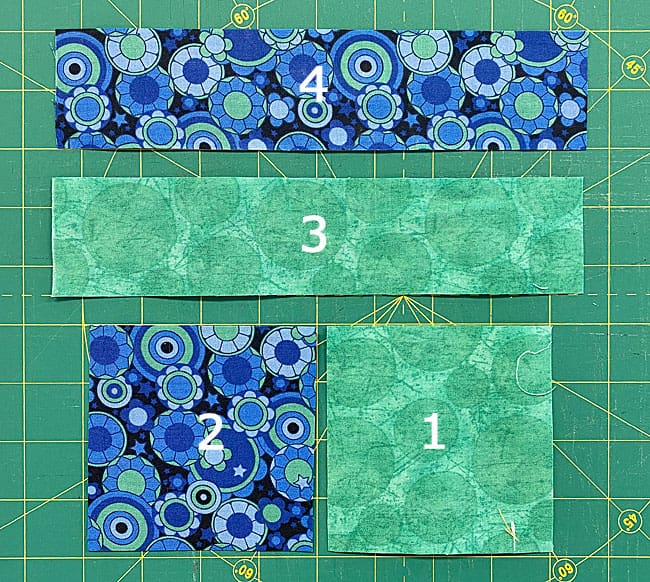
Step 2: Assemble the units for a Buckeye Beauty
Half Square Triangles
Make 2
Using the Quick Piece technique for making half square triangle, draw a diagonal line on the back of one of your squares. I used a chalk pencil on this darker fabric.
With RST layer a #1 and #2 square and stitch a 1/4" from each side of the drawn line.
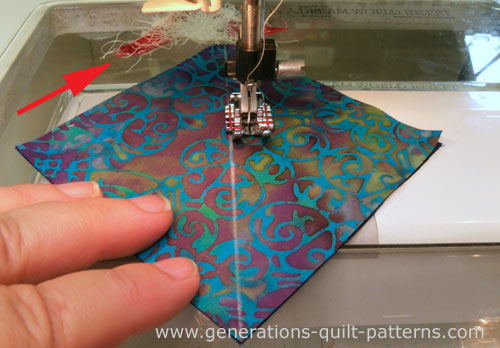 The red arrow points to my anchor cloth
The red arrow points to my anchor clothCut on the line to create two HST units.
Press.
If you cut oversized patches, use the chart below to find the 'Trim HST to...' size. If you cut your patches exactly, use this same measurement to check for accuracy. Make any necessary adjustments.
For our 6" sample, I'll trim the HST to 3-1/2" square.
HST Dimensions | |
|---|---|
| Finished Block Size | Trim HST to… |
| 3" | 2" |
| 4" | 2½" |
| 5" | 3" |
| 6" | 3½" |
| 7" | 4" |
Click here if you need more detailed information on the Quick Piecing technique used above. (This link opens in a new window to make it easier to come back to this spot to continue.)
Four Patches
Make 2
With RST, layer a #3 and #4 strip and stitch along the long edge to create a strip set.
After stitching, use the chart below to check that your strip set is the correct width.
Four Patch Measurements | |||
|---|---|---|---|
| Finished Block Size | Stripset Width after stitching | SubCut Width | Four Patch Dimensions |
| 3" | 2" | 1¼" | 2" |
| 4" | 2½" | 1½" | 2½" |
| 5" | 3" | 1¾" | 3" |
| 6" | 3½" | 2" | 3½" |
| 7" | 4" | 2¼" | 4" |
Now find the Subcut Width in the chart that corresponds to your finished block size.
Straighten one of the short edges with your rotary cutter and cut this strip set into four equal units. For our 6" sample that subcut is 2" wide.
Alternate the segments as shown below.
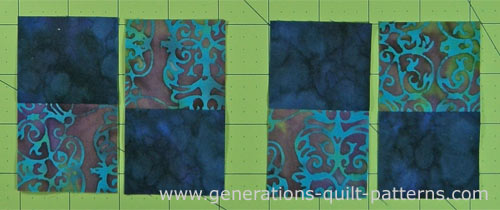
After stitching your four patches together, use the chart to check for accuracy. For our 6" sample they measure 3-1/2" square.
Step 3: Assemble the Buckeye Beauty Quilt Block
Lay out the units. Even though this is a simple quilt block, it is incredibly easy to flip the triangle squares. Unfortunately, we quilters never seem to notice until we've stitched a whole pile and are at the ironing board to press. ARGGGHHHH!!!!
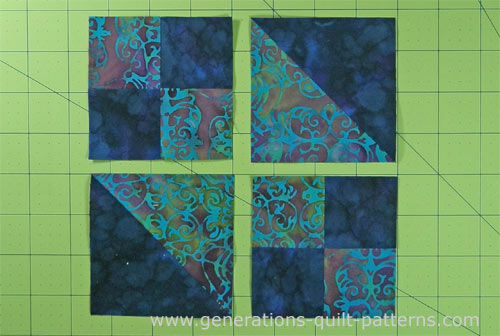
Stitch the patches into rows. You can press in either direction, just be consistent so that your seams will nest for ease in matching the seams.
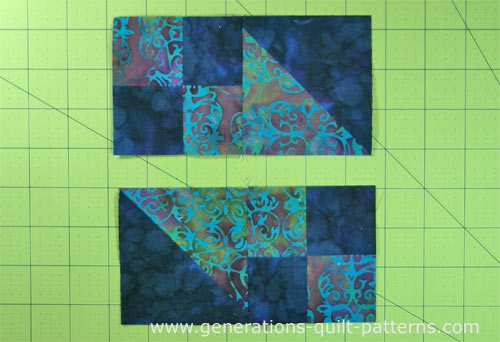
Sew the two rows into a block. I twirled the seam allowance to reduce bulk in the center of the block. (See the red circles in the photo below.)
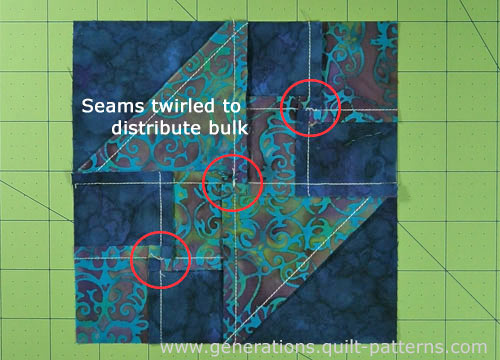
Let's take a closer look at the twirled seam allowance (circled in red below) on our Buckeye Beauty.
You'll need to pick out a couple of the stitches holding the seam together starting at the edge of the seam up to the stitching that crosses it. (the red arrows point to where I left the threads.) Then you are able to maneuver it into position.
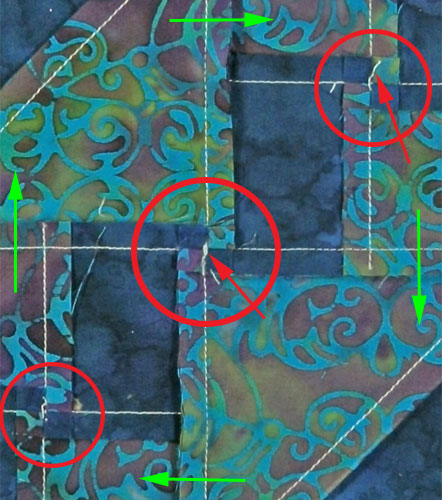
Instead of having the bulk of the seam all pressed to one side, it is now spread around the joined seam in a clockwise fashion. The green arrows show this rotation on this block.
Note that twirling the seam creates a little four patch on the back of the block.
This is your finished Buckeye Beauty quilt block. Pretty cute!
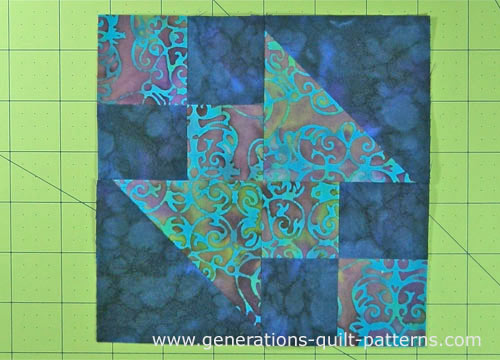
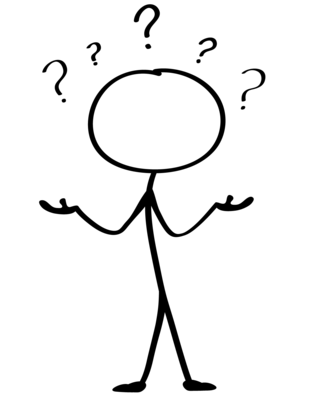
'Like the design, but need a bit more design opportunity within the block?
Then click here to go to our nine patch version of the Jacob's Ladder quilt block. It looks like two Buckeye Beauty's melded together.
Need help deciding how to lay out your finished blocks. Look to our Jacob's Ladder (alias Buckeye Beauty) pattern page for inspiration.
Common Variations
Clustering the Buckeye Beauty quilt block in groups of four allows for more design opportunities as we can see in the examples below.
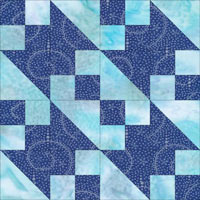
New Double Four Patch
The result of four blocks set together. Light and dark is reversed from our tutorial.
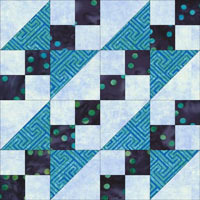
Buckeye Beautiful
Another fabric is added for the triangle patches.
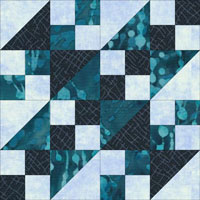
State House
Two different fabrics used for the triangle squares.
Also know as: Double Four Patch and New Four Patch
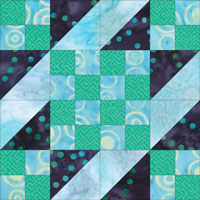
Sunny Lanes
In this four fabric block, the position of the units within the block are swapped.
The design is created by careful placement of the dark HST fabric to create the strong diagonal element.
Same name, different block...
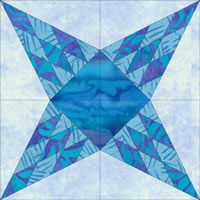
—A completely different look from the Buckeye Beauty quilt block in our tutorial.
This one is also known as the Rockingham's Beauty.
It's a real humdinger!
A Bevy of Beauties!
They say 'Beauty is in the eye of the beholder'!
Behold all the block patterns in our Free Quilt Block Pattern Library to find blocks for your next beautiful quilt!
What about a different quilt block?
For a list of all the 215+ quilt block patterns on this site, start here.
If you know the name of the block, shorten your search by using these links:
Click here if you're looking for blocks with at least some paper piecing.
Click here if you're looking for the basic building blocks of quilting, i.e., Flying Geese, half square triangles, quarter square triangles, etc., along with several techniques to make each.
And finally, use these links to find blocks in these finished sizes:
